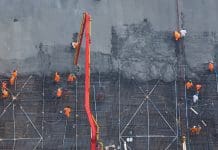A parliamentary inquiry has been told that procurement models must change and construction companies need to overcome a “lack of trust” if offsite manufacture is to become a success
The House of Lords Science and Technology Committee heard evidence from a multitude of expert witnesses as part of its first evidence session looking at the challenges involved in offsite manufacture for construction.
Phil Wilbraham, who is leading the construction of the third runway at Heathrow Airport, said that early client involvement was vital for making offsite manufacturing more common.
Explaining the benefits of offsite manufacture, from reduced cost and time, to improved quality and health and safety standards, he said it was crucial clients specified offsite construction methods early.
Wilbraham told peers: “It is so important that the first stage of the design is carried out with offsite manufacturers in mind because otherwise designers will generally design the way they have always designed and we will get the same answers.
“The real win here is if components are made in factory and are the same again and again.”
He added that using offsite methods fundamentally changed the way in which construction sites work, requiring new skills and a different approach.
Professor Jennifer Whyte, director of the Centre for Systems Engineering and Innovation at Imperial College London also highlighted the importance of clients getting on board, as well as the need to change the way in which work was procured.
“You cannot change technologies in production without changing business and procurement models. We have known that for a while,” she said.
She called for more research and training to help realise the offsite sector’s potential.
“There is a need for a fundamental research base as we move to more digital fabrication techniques,” she said.
“There are opportunities around technologies like AI and robotics as we move forward that I think is important that we have a research base to support. We also need a skills base to support advanced manufacturing techniques.”
Meanwhile, Jamie Ratcliff, assistant director, Greater London Authority said there was a need for offsite manufacture but also several major barriers.
Ratcliff said: “From a housing point of view, if we are serious about the building the homes the country needs, we are just not going to do it through traditional construction.”
He also saw influences for its use emerging, such as the Build To Rent sector, where clients are keen to cut as much time off construction as possible in order to gain as much rent from the building as quickly as possible.
He also identified advantages to offsite construction on small sites where traditional construction methods are very expensive.
However, he added that a lack of trust among construction firms was hindering progress.
He said: “One challenge that is really fundamental to the way the construction industry works is that it is just really bad at partnerships and collaboration.
“People don’t trust each other and to make this work you do need that trust relationship and you do need to work together at an early stage. You need to commit to it and you need to depend on your partners and work through the problems and for whatever reasons culturally lots of people in construction find that very difficult.
“You will also hear a lot of discussion around innovative technologies not being tried and tested and there being problems with them but I just don’t buy that.
“Mostly we are not talking about fantastical things like aerogel. It is tried and tested ways of building homes three different ways: timber frame buildings which have been around for thousands of years, steel frame buildings which have been around for 150 years and concrete frame buildings which have been around for 125 years.”
Tim Carey, national product director, at Willmott Dixon said offsite construction was still “very much a cottage industry.”
“A lot of the offsite manufacturers want to scale up and want to invest but there isn’t the certainty,” he said.
“There is a lack of harmonisation of design standards, particularly in the affordable sector. To get to scale and efficiency it makes it more difficult than it could otherwise be. If we could solve that problem then we could really get volume,” he added.













